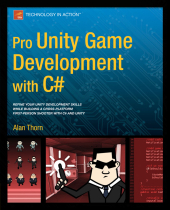 Neuerscheinungen 2014Stand: 2020-02-01 |
Schnellsuche
ISBN/Stichwort/Autor
|
Herderstraße 10
10625 Berlin
Tel.: 030 315 714 16
Fax 030 315 714 14
info@buchspektrum.de |

Alan Thorn
Pro Unity Game Development with C#
2014. xv, 348 S. 183 SW-Abb. 254 mm
Verlag/Jahr: SPRINGER, BERLIN; APRESS 2014
ISBN: 1-430-26746-1 (1430267461)
Neue ISBN: 978-1-430-26746-1 (9781430267461)
Preis und Lieferzeit: Bitte klicken
In Pro C sharp for Unity , Alan Thorn, author of Learn Unity for 2D Game Development and experienced game developer, takes you through the complete C sharp workflow for developing a cross-platform first person shooter in Unity. C sharp is the most popular programming language for experienced Unity developers, helping them get the most out of what Unity offers. If youŽre already using C sharp with Unity and you want to take the next step in becoming an experienced, professional-level game developer, this is the book you need.
Whether you are a student, an indie developer, or a season game dev professional, youŽll find helpful C sharp examples of how to build intelligent enemies, create event systems and GUIs, develop save-game states, and lots more.
YouŽll understand and apply powerful programming concepts such as Singleton Classes, Component Based Design, Resolution Independence, Delegates, and Event Driven Programming.
By the end of the book, you will have a complete first person shooter game up and running with Unity. Plus youŽll be equipped with the know-how and techniques needed to deploy your own professional-grade C sharp games.
If you already know a bit of C sharp and you want to improve your Unity skills, this is just the right book for you.!
1. Outlining the Game Structure in Terms of C sharp
2. Optimizing Import Workflows and Import Settings
3: The Game Loop and Developiong a Custom Event-Handling System
4. Building a Cross-Platform Controller
5. Enemies, NPCs, and Artificial Intelligence
6. Custom Weapons: Targeting, Feedback, and More
7. Modifying Game Behavior with Power-ups and Collections
8. The Graphical User Interface and Resolution Independence
9. Persistent Data and Save Game States
10. Final Touches: Polishing and Play-testing


